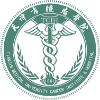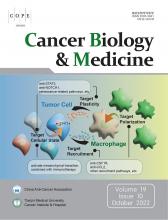Research ArticleOriginal Article
Clinical management and survival outcomes of patients with different molecular subtypes of diffuse gliomas in China (2011–2017): a multicenter retrospective study from CGGA
Kenan Zhang, Xing Liu, Guanzhang Li, Xin Chang, Shouwei Li, Jing Chen, Zheng Zhao, Jiguang Wang, Tao Jiang and Ruichao Chai
Cancer Biology & Medicine October 2022, 19 (10) 1460-1476; DOI: https://doi.org/10.20892/j.issn.2095-3941.2022.0469
Kenan Zhang
1Department of Molecular Pathology, Beijing Neurosurgical Institute, Capital Medical University, Beijing 100070, China
Xing Liu
2Department of Neuropathology, Beijing Neurosurgical Institute, Capital Medical University, Beijing 100070, China
Guanzhang Li
1Department of Molecular Pathology, Beijing Neurosurgical Institute, Capital Medical University, Beijing 100070, China
3Department of Neurosurgery, Beijing Tiantan Hospital, Capital Medical University, Beijing 100070, China
Xin Chang
4Department of Neurosurgery, Beijing Sanbo Brain Hospital, Capital Medical University, Beijing 100093, China
Shouwei Li
4Department of Neurosurgery, Beijing Sanbo Brain Hospital, Capital Medical University, Beijing 100093, China
Jing Chen
1Department of Molecular Pathology, Beijing Neurosurgical Institute, Capital Medical University, Beijing 100070, China
Zheng Zhao
1Department of Molecular Pathology, Beijing Neurosurgical Institute, Capital Medical University, Beijing 100070, China
Jiguang Wang
5Division of Life Science and State Key Laboratory of Molecular Neuroscience, Department of Chemical and Biological Engineering, The Hong Kong University of Science and Technology, Clear Water Bay, Kowloon, Hong Kong SAR 999077, China
6Hong Kong Center for Neurodegenerative Diseases, Hong Kong Science Park, Hong Kong SAR 999077, China
7HKUST Shenzhen-Hong Kong Collaborative Innovation Research Institute, Futian, Shenzhen 518057, China
Tao Jiang
1Department of Molecular Pathology, Beijing Neurosurgical Institute, Capital Medical University, Beijing 100070, China
3Department of Neurosurgery, Beijing Tiantan Hospital, Capital Medical University, Beijing 100070, China
Ruichao Chai
1Department of Molecular Pathology, Beijing Neurosurgical Institute, Capital Medical University, Beijing 100070, China
2Department of Neuropathology, Beijing Neurosurgical Institute, Capital Medical University, Beijing 100070, China
5Division of Life Science and State Key Laboratory of Molecular Neuroscience, Department of Chemical and Biological Engineering, The Hong Kong University of Science and Technology, Clear Water Bay, Kowloon, Hong Kong SAR 999077, China

References
- 1.↵
- 2.↵
- Jiang T,
- Nam DH,
- Ram Z,
- Poon WS,
- Wang J,
- Boldbaatar D, et al.
- 3.↵
- 4.
- Liu J,
- Li C,
- Wang Y,
- Ji P,
- Guo S,
- Zhai Y, et al.
- 5.↵
- Zheng R,
- Zhang S,
- Zeng H,
- Wang S,
- Sun K,
- Chen R, et al.
- 6.↵
- 7.↵
- Xu YY,
- Gao P,
- Sun Y,
- Duan YR.
- 8.↵
- 9.↵
- Chai R,
- Li G,
- Liu Y,
- Zhang K,
- Zhao Z,
- Wu F, et al.
- 10.↵
- Yan H,
- Parsons DW,
- Jin G,
- McLendon R,
- Rasheed BA,
- Yuan W, et al.
- 11.
- 12.↵
- Xie Y,
- Tan Y,
- Yang C,
- Zhang X,
- Xu C,
- Qiao X, et al.
- 13.↵
- 14.↵
- Chai RC,
- Li YM,
- Zhang KN,
- Chang YZ,
- Liu YQ,
- Zhao Z, et al.
- 15.↵
- 16.↵
- 17.
- 18.↵
- Chai RC,
- Zhang KN,
- Chang YZ,
- Wu F,
- Liu YQ,
- Zhao Z, et al.
- 19.↵
- 20.↵
- Wahl M,
- Phillips JJ,
- Molinaro AM,
- Lin Y,
- Perry A,
- Haas-Kogan DA, et al.
- 21.↵
- Cairncross G,
- Wang M,
- Shaw E,
- Jenkins R,
- Brachman D,
- Buckner J, et al.
- 22.↵
- Ding X,
- Wang Z,
- Chen D,
- Wang Y,
- Zhao Z,
- Sun C, et al.
- 23.↵
- Jakola AS,
- Pedersen LK,
- Skjulsvik AJ,
- Myrmel K,
- Sjavik K,
- Solheim O.
- 24.↵
- Hou Z,
- Zhang K,
- Liu X,
- Fang S,
- Li L,
- Wang Y, et al.
- 25.↵
- 26.↵
- Zhao Z,
- Zhang KN,
- Wang Q,
- Li G,
- Zeng F,
- Zhang Y, et al.
- 27.↵
- Chai RC,
- Zhang KN,
- Liu YQ,
- Wu F,
- Zhao Z,
- Wang KY, et al.
- 28.↵
- Orringer D,
- Lau D,
- Khatri S,
- Zamora-Berridi GJ,
- Zhang K,
- Wu C, et al.
- 29.↵
- 30.↵
- Mijderwijk HJ,
- Nieboer D,
- Incekara F,
- Berger K,
- Steyerberg EW,
- van den Bent MJ, et al.
- 31.↵
- 32.↵
- 33.↵
- Rossi M,
- Gay L,
- Ambrogi F,
- Conti Nibali M,
- Sciortino T,
- Puglisi G, et al.
- 34.↵
- Mair MJ,
- Geurts M,
- van den Bent MJ,
- Berghoff AS.
- 35.↵
- 36.↵
- Stoyanov GS,
- Lyutfi E,
- Georgieva R,
- Georgiev R,
- Dzhenkov DL,
- Petkova L, et al.
- 37.
- Mizoguchi M,
- Hata N,
- Kuga D,
- Hatae R,
- Akagi Y,
- Sangatsuda Y, et al.
- 38.
- Ostrom QT,
- Shoaf ML,
- Cioffi G,
- Waite K,
- Kruchko C,
- Wen PY, et al.
- 39.↵
- Brown NF,
- Ottaviani D,
- Tazare J,
- Gregson J,
- Kitchen N,
- Brandner S, et al.
- 40.↵
- 41.↵
- 42.↵
- Albuquerque LAF,
- Almeida JP,
- de Macedo Filho LJM,
- Joaquim AF,
- Duffau H.
- 43.↵
- Still MEH,
- Roux A,
- Huberfeld G,
- Bauchet L,
- Baron MH,
- Fontaine D, et al.
- 44.↵
- Robe PA,
- Rados M,
- Spliet WG,
- Hoff RG,
- Gosselaar P,
- Broekman MLD, et al.
- 45.↵
- Mladenovsk M,
- Valkov I,
- Ovcharov M,
- Vasilev N,
- Duhlenski I.
- 46.↵
- Hollon T,
- Hervey-Jumper SL,
- Sagher O,
- Orringer DA.
- 47.↵
- Mirza FA,
- Shamim MS.
- 48.↵
- Gutman DC,
- Young RJ.
- 49.
- Singh G,
- Manjila S,
- Sakla N,
- True A,
- Wardeh AH,
- Beig N, et al.
- 50.↵
- Kazerooni AF,
- Bakas S,
- Rad HS,
- Davatzikos C.
- 51.↵
- Li Y,
- Qian Z,
- Xu K,
- Wang K,
- Fan X,
- Li S, et al.
- 52.
- Fang S,
- Liang Y,
- Li L,
- Wang L,
- Fan X,
- Wang Y, et al.
- 53.↵
- Liu X,
- Li Y,
- Li S,
- Fan X,
- Sun Z,
- Yang Z, et al.
- 54.↵
- Yu Y,
- Villanueva-Meyer J,
- Grimmer MR,
- Hilz S,
- Solomon DA,
- Choi S, et al.
- 55.↵
- Gramatzki D,
- Felsberg J,
- Roth P,
- Kaulich K,
- von Deimling A,
- Rushing EJ, et al.
- 56.↵
- Tavelin B,
- Malmstrom A.
- 57.
- Moore KJ,
- Moertel CL,
- Williams LA.
- 58.
- Wang GM,
- Cioffi G,
- Patil N,
- Waite KA,
- Lanese R,
- Ostrom QT, et al.
- 59.↵
- Alexopoulos G,
- Zhang J,
- Karampelas I,
- Patel M,
- Kemp J,
- Coppens J, et al.
- 60.↵
- Hirtz A,
- Rech F,
- Dubois-Pot-Schneider H,
- Dumond H.
- 61.↵
- Eldesouki S,
- Samara KA,
- Qadri R,
- Obaideen AA,
- Otour AH,
- Habbal O, et al.
- 62.↵
- 63.↵
- 64.↵
- Huang LE.
- 65.↵
In this issue
Clinical management and survival outcomes of patients with different molecular subtypes of diffuse gliomas in China (2011–2017): a multicenter retrospective study from CGGA
Kenan Zhang, Xing Liu, Guanzhang Li, Xin Chang, Shouwei Li, Jing Chen, Zheng Zhao, Jiguang Wang, Tao Jiang, Ruichao Chai
Cancer Biology & Medicine Oct 2022, 19 (10) 1460-1476; DOI: 10.20892/j.issn.2095-3941.2022.0469
Clinical management and survival outcomes of patients with different molecular subtypes of diffuse gliomas in China (2011–2017): a multicenter retrospective study from CGGA
Kenan Zhang, Xing Liu, Guanzhang Li, Xin Chang, Shouwei Li, Jing Chen, Zheng Zhao, Jiguang Wang, Tao Jiang, Ruichao Chai
Cancer Biology & Medicine Oct 2022, 19 (10) 1460-1476; DOI: 10.20892/j.issn.2095-3941.2022.0469
Jump to section
Related Articles
Cited By...
- Efficacy and safety of anlotinib combined with the STUPP regimen in patients with newly diagnosed glioblastoma: a multicenter, single-arm, phase II trial
- Erratum to Clinical management and survival outcomes of patients with different molecular subtypes of diffuse gliomas in China (2011-2017): a multicenter retrospective study from CGGA
- Mining multi-omics data for molecular subtyping in gliomas facilitates precise clinical treatment
- Identification of the E2F1-RAD51AP1 axis as a key factor in MGMT-methylated GBM TMZ resistance
- Development of glioblastoma organoids and their applications in personalized therapy










